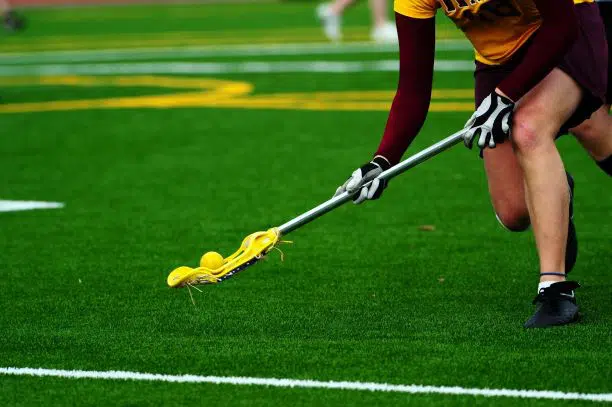A mesh net on a stick, a goal on either end of the field, and a bouncy ball to maneuver through the rival team’s goalie—lacrosse is an exciting and intense game!
But is lacrosse more difficult than field hockey? Well, yes! Lacrosse is a more difficult sport to play than field hockey due to its fast-paced nature, its stricter rules, and the generally more complex techniques required to transport the ball successfully from one end of the field to another.
I’ve been lucky enough to play both over several seasons, and in this article, I’ll tell you all the differences between these two noble sports!
Read on to find out in detail the number of ways in which lacrosse and field hockey differ, and how lacrosse can be considered the tougher sport out of the two.

1. Offside Rules
The first reason that I think lacrosse comes across as more challenging than field hockey is the stricter off-side rule in the former.
In lacrosse, when a team has more than six players in the offensive half of the field, it is considered to be off-side. An off-side penalty means a loss of possession for the team, and thus the players are required to be acutely aware of every other member of their team in case they cause a penalty to occur.
In contrast, field hockey does not have any off-side rules which makes it much easier for players to score a goal without worrying about the positions of other team members.
2. The Crosse vs. The Hockey Stick
Another reason why lacrosse is the more difficult sport is because of the design of the lacrosse stick (also known as the ‘crosse’).
You probably have a visual of it in your mind right now: the head of the lacrosse stick is roughly triangular in shape and fitted with loose netting to secure and carry the ball once it is in your possession (a maneuver known as cradling).
The shape makes it a challenge to pass the ball to a team member or to steal it from the opposition.
In comparison, a hockey stick has a curved head that is perfect for passing, shooting, tackling, or dribbling the ball. This is much easier than having to catch the ball in the crosse net.
3. Manoeuvers
Since field hockey requires the ball to stay on the ground, the hockey stick does not need to perform too many complex maneuvers to transport the ball through the field.
Although you can only use the flat end of the hockey stick to hit the ball, the ball remains earth-bound.
Unlike field hockey, the ball in lacrosse games is usually airborne. This means that cradling the ball, tackling an opponent, gaining possession, and scoring a goal are all feats that require a multifaceted control on the crosse as well as on the ball.
It is no big deal for professional lacrosse players who have much practice, but for new players, this may be a deciding factor between the two games.
4. Lighter Ball
Another key difference between lacrosse and field hockey is the dimensions of the balls in play.
For field hockey, the ball has a little more weight which makes it easier to throw and manipulate.
The lacrosse ball, on the other hand, is lighter since it has to be cradled within the crosse and carried.
The lighter weight of the ball makes it more difficult for players to make sure it travels in the right direction when thrown.
Plus, factors like weather and wind affect a lighter ball much more than they would with one having more weight. So, a lighter ball makes the gameplay more difficult as compared to a slightly heavier ball in field hockey.

5. Safety Gear
One more way in which lacrosse is more challenging than field hockey is all the safety gear required for lacrosse.
As mentioned before, the ball in field hockey stays on the ground and, hence, the only safety gear required is shin guards, mouth guards, gloves, and goggles.
On the other hand, lacrosse involves the ball being hit up in the air with speed and intensity.
This means that lacrosse players have to wear helmets (only men), goggles, cleats, mouth guards, gloves, and elbow and shoulder pads in order to protect themselves during gameplay.
Wearing all this safety kit makes swift movement and maneuvering more difficult for lacrosse players when compared to those who play field hockey. And despite all this gear, it is still more likely for a lacrosse player to get injured compared to a player of field hockey.
6. Injuries
We just mentioned that lacrosse players require more safety gear—this isn’t without reason.
Lacrosse players on average get more injuries as compared to field hockey players. There has been some quite extensive research done into the nature and number of injuries common in lacrosse. (Source)
The chances of the ball landing on some unprotected body part are very high since the ball is usually airborne in lacrosse. This is a detail that we must factor in when deciding which game is harder to play.
You guessed it, our vote is for lacrosse!
7. Faster Pace
The pace is probably one of the main playing aspects of lacrosse that makes it more difficult to play than field hockey.
While both games have 60-minute total gameplay, field hockey is played in two 30-minute halves, and lacrosse is played in four quarters consisting of 15 minutes each.
This division of time makes lacrosse much more intense and faster-paced as compared to field hockey since players are focused on scoring a goal before the quarter ends.
The pace also accounts for the difficulty level one might associate with lacrosse when watching a game in action.
8. Gender Differences
An interesting feature of lacrosse is the differences in male and female games.
The main difference is the amount of contact that is allowed on the field. If you are playing women’s lacrosse, there is limited body contact permissible.
Moreover, the dimensions of the field, the equipment, and even the number of players on the field are different; creating almost two diverse versions of lacrosse. So, if you are a woman playing lacrosse, it might be even tougher to manoeuver the ball with limited contact between players.
9. History And Heritage
In earlier times, lacrosse was called ‘The Creator’s Game’, and was played by a hundred to a thousand players on each team at one time!
The game was much more intense and lasted a good two to three days—the game was almost a spiritual act for indigenous people of North America, played for the ‘creator.’
Wrapping Up
While the fascinating heritage associated with lacrosse might not necessarily make it more difficult to play, there is definitely a sense of respect expected towards the sport. Being a recognized Olympic sport also gives lacrosse its sense of seriousness.
In recent times, there have been a lot of negative attitudes associated with lacrosse.
The main reason for that is not the game itself, but the stereotypes and the culture that surround it. People don’t know enough about the game to judge it fairly, so they consider the likeability of players to be a factor in their verdict.
The ‘Lax Bro’(lacrosse-playing jock) stereotype is a pretty common one, but players are defying these labels every single day.
In any case, whether you are acquainted well with lacrosse and field hockey or just starting out, we hope that our detailed comparison will help you make a better decision about which game to invest yourself in. The difficulty of the sport may matter in the beginning, but once you get the hang of the rules, there is no reason for you to feel inadequate.
So bring out your hockey sticks, or crosses for that matter, and gather a team of players—you are in for a fun game one way or another!
